The online world is big and as a seller, it can be challenging to find your way around. Which platforms are popular? Which marketplace suits your business? Where does your target audience go shopping online?
We’ve made a list of 5 different marketplaces explaining what they are, where they operate, the positives, the negatives, and their fees.
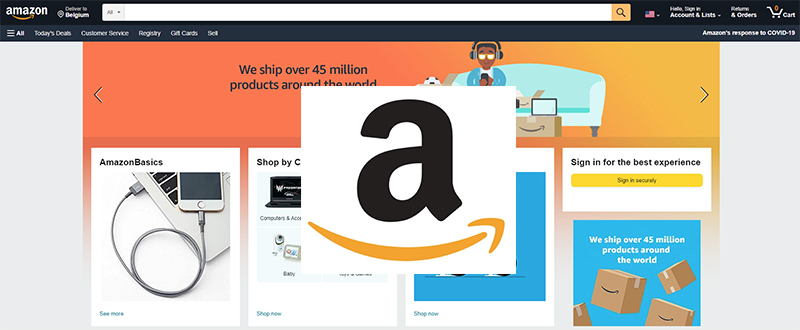
Inside this article
Amazon
First up: Amazon. The biggest online marketplace in the world. If you need a (re)introduction. Here it is!
What is Amazon?
Once upon a time, Amazon was a small online book seller. Oh, how times have changed! Nowadays it is a multi-category marketplace that sells just about anything you can think of. Amazon’s top categories are:
- Toys and games
- Electronics
- Books
- Apparel and jewelry
Where is Amazon Active?
Amazon hosts marketplaces for retailers all over the world, making it a truly global brand.
- In the US alone, Amazon has 95 million users who are Prime subscribers.
- Germany was the second-largest market for Amazon last year.
- The UK, whose Amazon marketplace has a huge share of the eCommerce industry.
Amazon’s Pros
Amazon is an experienced and well-established platform. It’s easy for small businesses to join and sell.
Global
Although Amazon is a good place for a small business to sell, it’s truly a global phenomenon. If you’re looking to expand, Amazon just might be online selling route for you.
Logistics
Amazon offers something called “Fulfillment by Amazon” (FBA). This means that you can send (a part) of your stock to Amazon and from there one, they will take care of everything for you. They’ll store your products, package, and ship them. That’s obviously a huge time-saver for you!
Low marketing costs
Amazon already has millions of customers on their website every day. Their website functions as a search engine, so by joining Amazon, shoppers looking for your products can easily find you. This brings your business one step closer to a lot of new customers, without any significant marketing efforts. Beware, however! One step closer isn’t necessarily far. A lot depends on how big the market is that you are selling in. It’s not easy to stand out on Amazon, it will be your job to perfect your listings, so your Amazon presence really pays off.
Amazon’s Cons
Every marketplace has its downsides and Amazon is no exception.
Competition
Amazon’s wide reach is its biggest advantage, but also disadvantage. Competition is fierce and as a seller, you need a long-term strategy to tackle this. First, put maximal effort into your listings. Don’t leave shoppers wondering or doubting about anything. Be as informative as possible. Secondly, offer the best customer service. This includes answering customers’ questions, keeping your availability up to date and fulfilling orders on time. Finally, focus and invest in getting good feedback from your buyers.
High demands
The strong competition will force you to stay on top of your game, but so will Amazon itself.
Amazon will want to receive updated product data every day. They require all products to have an ASIN-number and all uploads must be done via the Amazon-API. This is no job for a small business owner to do on their own.
Either you add your product data to an inventory file and upload it, an option that is only feasible if you don’t have a lot of products to add, or you rely on a third-party data feed tool to deal with the technicalities.
Amazon’s fees
Amazon has two selling plans:
- Professional – $39.99/mo. with no per item fee
- Individual – no subscription fee but $0.99 fee per item sold
The individual selling plan will suit you if you are planning on selling less than 40 items a month. In any other case, the Professional plan will work best for you.
Whatever your selling plan, sellers need to pay a referral fee for every sold item. This fee varies per product category. It can range from 8% to 96%. For a full list of the fees, consult the Amazon Seller Central website.
Moreover, Fulfillment by Amazon offers a lot of perks, but it comes with a price. You will have to pay fulfillment fees per item and pay for storage. It’s up to you to decide whether these fees are worth it.
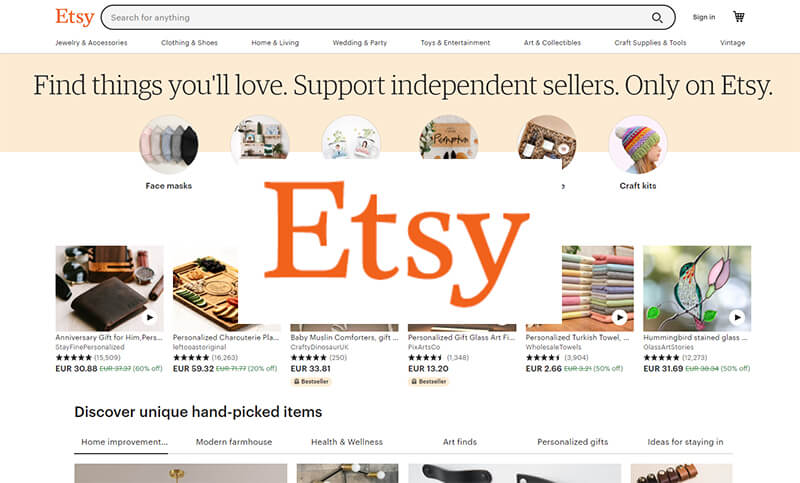
Etsy
Etsy has a very different business model to Amazon, but nevertheless, is very successful. As of 2020, close to 81.9 million buyers had purchased goods through Etsy.
What is Etsy?
Etsy is the place to be if you’re selling unique and vintage items. Etsy customers are specifically looking for something handmade and special.
This is one of the best online marketplaces for sellers with artistic hobbies or talents. Some of the popular product categories are:
- Party décor
- Craft supplies
- Jewelry and hair accessories
- Wall art
Where is Etsy Active?
Like Amazon, you can find Etsy almost anywhere in the world.
- The US accounts for around 65% of Etsy’s overall sales.
- In the UK Etsy is a very popular platform for small businesses and shoppers.
Yet, Etsy is truly a global marketplace allowing you to send your crafts off to any place in the world.
Etsy’s Pros
Much like Amazon, setting up an Etsy store is a simple task.
Quick and Easy
It is very easy to start selling on Etsy. You don’t need to be an amazing with technology to start up because the interface is very straightforward. It is easy to add or edit listings. You can even customize your storefront. It’s very user-friendly for both sellers and buyers, so you have your hands free to get crafty and focus on your products.
Community Spirit
What makes Etsy stand out as an online marketplace is the community spirit. Active Etsy users are guaranteed to be interested in arts and crafts. If this is in line with what you are selling, you’ll be sure to reach to right audience on Etsy.
Learning Ground
Etsy offers its sellers a lot of tips on how to sell and it’s known to have a community spirit among its sellers too, with makes advising each other. Furthermore, Etsy can serve as your test ground for grander plans. You can start to earn a little money, build your brand, and get to know your customers and their needs. There’s a lot to learn when starting a handmade business and Etsy could be the learning ground you’re looking for.
Etsy’s Cons
Like all marketplaces, being a third-party seller doesn’t always go without a hitch:
Competition
The downside of any popular marketplace is that it’s, well, popular. This means it’s tough to stand out. Even if your designs are unique, Etsy is saturated with uniqueness. It will take originality, top service, and raving reviews for your Etsy shop to get going.
Copycats
Considering that originality is the main selling point of your brand, and the wide reach Etsy has, copycats are a danger to every Etsy seller. It helps to establish your brand in more ways than just having an Etsy shop. This will make it harder for copycats to steal your customers.
Limited to Etsy Users
Like Amazon, Etsy serves as a great search engine, but only within the platform of Etsy itself.
If you’re searching Etsy for a plant hanger for your sister-in-law, you’ll find the best listings on Etsy for handmade plant hangers. However, if you’re searching Google for handmade plant hangers – which far more people would do – the listings on Etsy will come up at the bottom of the search results on Google (unless you have a very popular Etsy store).
That’s just the way it is, so if you’re selling on Etsy, focus on ranking higher within Etsy. Make sure you’re tagging your items properly. Once you have products to sell, you can optimize your items for search by using keywords in your item title, adding your shop location, and naming your shop sections to boost SEO.
Etsy’s Fees
Unlike some bigger marketplaces, Etsy makes its fees very clear.
There are listing fees and transaction fees. You’ll be charged $0.20 per product listed, plus 5% commission for every item sold.
Joining the platform is free, although you can choose to pay a monthly subscription fee with perks like customizable storefronts.
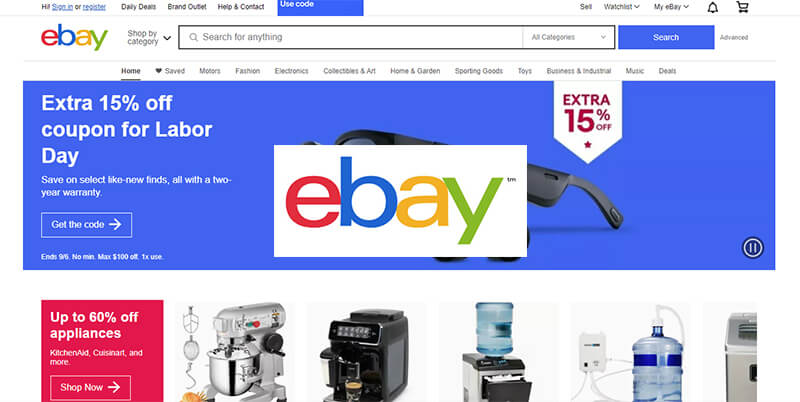
eBay
Everyone has heard of eBay, right? Last year, eBay reach 185 million active buyers worldwide.
Here’s what should you know about eBay if you want to start selling.
What is eBay?
eBay started off as an auction site and later added a ‘buy it now’ feature for those of us who aren’t into bidding wars. It’s a popular marketplace for used goods, but it’s also possible to start a business selling new products on eBay. Popular goods on eBay are:
- Electronics
- Health and beauty products
- Video games
- Books
- Furniture
Where is eBay Active?
- If you’re keen to sell on this platform, check out the user demographics. Like many online marketplaces, eBay appeals to some age groups more than others.
- Most of the eBay sellers are in the UK and the US. Germany completes the top three and is followed by China.
eBay’s Pros
A well-established marketplaces like eBay come with lots of benefits.
Sell Anything
eBay sells more than just second-hand goods. Although it’s still an option, over 80% of products sold on eBay are new. No matter what your niche, there’s an audience on eBay waiting for you. Books, electronics, clothing, handmade items, car parts… the list goes on and on.
The Reach
You have a global reach. Just like Amazon, eBay allows you to target one of the biggest customer bases in the world. Also, a sale on eBay doesn’t necessarily end there. You can use an eBay sale as an opportunity to inform your customer about your own web shop. This way, eBay works as a marketing tool as well as a sales platform.
eBay’s Cons
All stories have two sides. Here are the downsides you should consider before selling on eBay.
Value fees
eBay charges a value fee. This is 10% of the sold price of an item, which can vary wildly depending on what you sell. Frankly, if your profit margins are low, it might not be a good idea to start selling on eBay at all. Luckily, there’s a clear structure laid out on eBay’s help site and even a fee calculator to help you figure out how the fees will impact your revenue.
Competition
Yet again, a big platform like eBay comes with a lot of competition. As you’d expect from most huge online marketplaces, it can be difficult to stand out here. It’s important to keep your eye on the competition and to (re-)assess your own business. Is your market highly saturated? Can you beat your competitor’s prices? You may decide to not list certain items, or you will have to think of a way to make them stand out, selling items as a package or gift box for example.
eBay’s Fees
On top of the transaction fee mentioned above, eBay has a long list of seller fees, depending on who you are and how often you sell.
Subscribers can pay from between $8 per month as a ‘starter’ and up to $350 per month as an ‘anchor’. You can also pay varying listing fees if you want to implement upgrades.
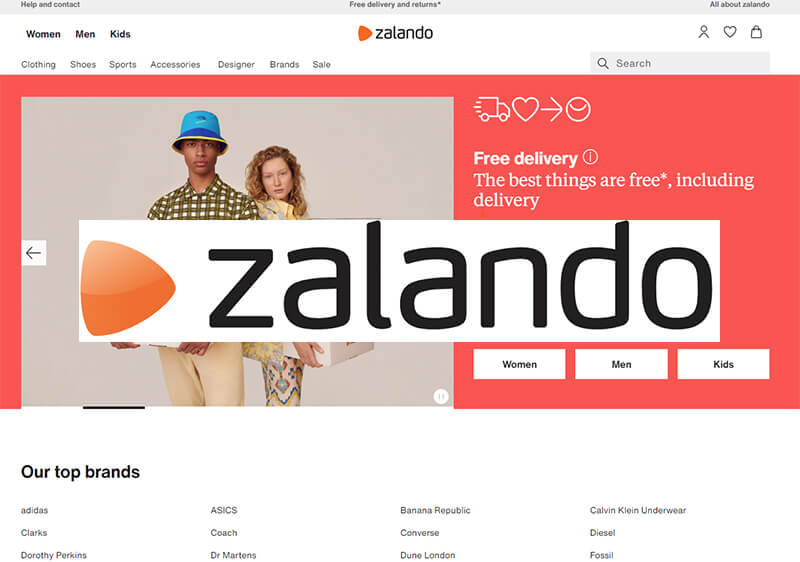
Zalando
If you’re selling fashion, Zalando’s the platform for you.
The company started out as a Berlin-based shoe retailer and is now selling thousands of products in 17 countries as one of the top online marketplaces in Europe.
What is Zalando?
Zalando is all about clothing and accessories. There are nearly 2,000 brands on offer in this marketplace, with shoppers able to find both low- and high-end options.
Zalando is the go-to place to sell:
- Clothing for men, women, and kids
- Sportswear
- Designer labels
- Accessories
Where is Zalando Active?
Zalando reported that 31 million customers ordered on its website last year. It’s the most important marketplace for clothing in Europe. Within its 17-country radius, Zalando is most popular in:
- Germany, its home base
- Austria
- the UK, but which marketplace isn’t popular there?
Zalando’s Pros
Zalando has a very specific business model. In contrast to the platforms, we’ve discussed so far, you already need to have an online store to be considered as a brand for this marketplace.
What are the perks?
Grow
Zalando is a blooming business. It’s already reaching an international audience and the future looks promising. Selling on Zalando can introduce you to lots of new audiences. Zalando demands a lot from its sellers. Shipping services, for example, need to be approved by Zalando before you can use them. Although it might seem like a hassle to tick all these requirement boxes at first, it has the huge advantage of getting you off on the right foot straight away.
Helpful
Which brings us to a second point: Zalando is helpful! It has teams on hand to guide you in becoming and thriving as a seller. It’s also possible for sellers to make use of Zalando’s Marketing Services. They can offer you insight into their customer data or help you with your branding and storytelling. Zalando is a great platform to sell and learn.
Zalando’s Cons
You might have spotted some cons already.
Limited
Zalando is selective about the companies it works with and the goods you can sell. This is good for limiting the competition, but it might also be too exclusive for your business.
Zalando is not for you if:
- You’re not based in one of the 17 countries it sells in. Mind you, Zalando is growing fast. If the platform isn’t in your country yet, it might be coming soon.
- You don’t have an online store or brand presence. If you’re completely new to selling online, you will not be able to sign up as a Zalando seller.
- You don’t meet their requirements. Zalando maintains high product and service standards and you must live up to them to sell on their platform. For example, every seller must work with approved couriers and must allow a 100-day returns window. If that’s not for you, you’re out!
Technical
As you can see, Zalando comes with a lot of requirements. It’s also not so quick and easy to start selling on this platform. First, your registration needs to be approved. Secondly, much like Amazon, things can get quite technical to set up.
You will most likely need your in-house tech team to help you or, if you don’t have one, seek help from a third-party integrator to get your stock up on Zalando.
Zalando’s Fees
Here’s the good news: there are no fees for product listings nor are there commission rates for your sales.
While this is great news for your sales, this marketplace has very strict rules. Consider them carefully, before you choose to join.
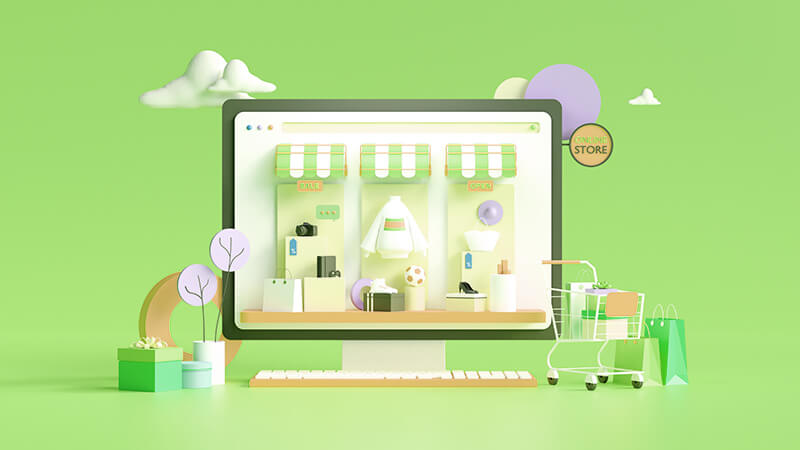
Your Own Website
Why do you need a marketplace to sell on? Why not use your own website?
What should you consider?
If you make your own website, everything is in your hands. It’s the easiest way to showcase your brand, your products, and your service proposition. Invite customers into your brand story.
SEO
When we say everything is in your hands, we don’t just mean the pictures and words, we also mean the extent of your website’s global reach. You will need to put some research into your target market before you dive into the world of online retail. You could find where and how you need to appeal by:
Doing keyword research. Which words will people use to find your eCommerce site?
Checking out your competition. Find out what others are doing, which prices they are setting and what their service offers. Is this what you want to do? What can you do to stand out?
Asking around. It’s not because your business is online that you can’t ask friends, family or whoever, what they think about your products and what service they would expect from you.
Website Pros
You’re in charge of your sales and every aspect of the sales process. You can choose a shipping carrier to work with or take care of postage on your own.
You won’t be competing with other sellers. All online marketplaces are hard to stand out in, but your own website is completely your domain.
You manage the product categories. Set up a table of contents that works for you. Want to add a new product category? That’s up to you.
Website Cons
Doing things on your own comes with more responsibility. You will have to come up with a plan and be organized. This means you will have to invest more time into your online presence. It will be completely up to you to drive traffic towards your website. If ease is more important to you than sales, stick to the online platforms.
Fees on your own website
That depends on where you build your site.
Find an eCommerce website builder you feel comfortable with. Some options are:
- Wix, an overall popular website builder.
- Shopify, good for larger stores.
- Weebly, popular among Entrepreneurs.
You’ll need to build your inventory as you would if you were selling on an online marketplace. There won’t be any seller fees for product listings or sales – you decide where your profits go.
Conclusion
If all the platforms, pros and cons have made you dizzy, don’t worry. There is no need to stick to one platform only.
If you set your business up with its own website, you can choose to partner up with online marketplaces, too.
Most marketplaces won’t demand exclusivity of your business. Just make sure that you have your inventory aligned. If you’ve sold an item on eBay, you can’t sell it again on Bonanza.
Whatever your marketplace, good luck with the sales!

